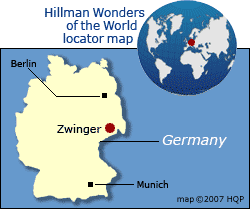Zwinger
 Why the
Zwinger
in Germany is special
Why the
Zwinger
in Germany is specialThe Zwinger in Dresden, Germany is a triumph in Baroque architecture and has museums with outstanding collections.
Zwinger tips and insights
Top two architectural marvels
Spend time relising these Zwinger highlights:
-
Crown Gate
See photo above.
- Nymphenbad
Visit the statue-rich "Bath of Nymphs".
Although they have different focuses, they have something in common: All have world-class collections.
-
One museum specializes in 16th to 18th century armory and weaponry, from Germany and beyond.
- Another displays antique porcelains from Saxony and the Far East.
- Yet another features historic scientific instruments and clocks.
- And, there's the art museum with artworks of great masters, including Rubens, Rembrandt and Raphael. The last artist created the Zwinger's most prized possession, the Sistine Madonna (see photo).
The Zwinger is a complex of buildings, pavilions and galleries ringing a vast quadrangle garden adorned with statuary, fountain pools, greenery and walkways. This hemmed in courtyard was sometimes used for lavish festivals, complete with music and fireworks. Visitors from throughout Germany would attend.
History in brief
The Zwinger was built in the early 1700s by Augustus the Strong, the ruler of Saxony and Poland.
The buildings in this German city were severely bombed in World War II and long lay in ruins.
Today, the Zwinger has been reconstructed. The priceless artwork was saved because it was removed and stored in secure locations before the Allied air raids over Germany.
Location in Germany



